History of commercial development
 Edo period
Edo period

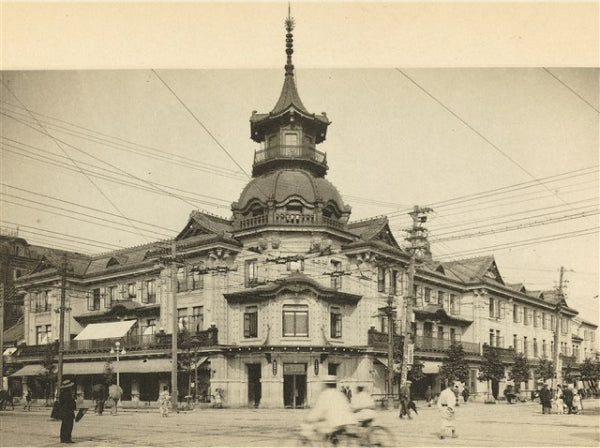
[Ieyasu Tokugawa's entry into Edo and the creation of a city]
In 1590, Ieyasu entered Edo Castle. At this time, Edo seemed to be a small post town, and most of the current Chuo-ku was the sea. Ieyasu, who gradually maintained the castle, opened the Shogunate in 1603 and made a large-scale construction at the same time, and by the following year most of the current Chuo-ku, except Tsukiji, was reclaimed. At the same time, there is also an arterial road connecting the Tokaido and Oshu Kaido, from Shimbashi to Kyobashi and Nihonbashi to Muromachi 3-chome, and shops are starting to build one after another.
[Formation of Shopping Street]
After the market supporting the stomach of the people of Edo was reclaimed, it was opened one after another.
This is a fish market in Nihonbashi and Kyobashi.
In addition, the shopping street spread from Honmachi, Otemmacho, Yokoyamacho, Bakurocho, and Hatagocho on the north side to Nihonbashi, Kyobashi, Ginza, and Shimbashi in the south. In the southern area, Kansai merchants who came to Tokyo after hearing rumors opened stores one after another. This was further boosted by the sankin kotai system established in 1635. By the great money of the daimyos, it was spurred by this.
[The Great Fire of the Meiryaku era]
However, in the New Year of 1657, the Great Fire of the Meiryaku era, which burned 60% of the city of Edo, has turned most of the current Chuo-ku ash.
However, with the active promotion of reconstruction of the Shogunate, we showed a wonderful recovery.
Since then, fires have occurred dozens of times until the Taisho era, but the power of Edo, which will be revived each time, is considerable.
[Genroku era]
During this period, which is said to be the development period of Osaka commerce, emerging merchants have emerged in Edo. The representative is Mitsui Echigo-ya, who has no current silver value. It was changed from a method of negotiating and deciding the price until then to a method of trading cash at a fixed price. When this commercial law came into effect, other kimono shops came to follow suit. It was also during this period that Shirakiya, the predecessor of Tokyu Department Stores, developed.
[Culture and Bunsei Period]
While the Edo culture reached its point, the number of restaurants in the commercial area increased dramatically.
It was at this time that Mojuro Sugimoto appeared. The cargo of the ten-gumi wholesalers in Edo was to be transported by Hishigaki Kaisen, but due to the aging of the Hishigaki Kaisen, the cargo from Osaka was tended to be delayed. Juro Shigeru, who became the head of the ten wholesaler, succeeded in turning a new ship into a Hishigaki cruise ship, and became a boss in the commercial world.
After that, he will lose his leg.
Prices and Breakdown in late Tokugawa shogunate
At one point after the opening of the country, the opening of a port near Yokohama disrupted the distribution channel, and prices of rice and cereals soared. Combined with the social psychology that the times are changing, the Edo prefecture was exposed to the wave of destruction for about three days.
In Chuo-ku, there was no damage as in other areas, but there seemed to be considerable examples of selling rice, burning, etc.
 Meiji period
Meiji period

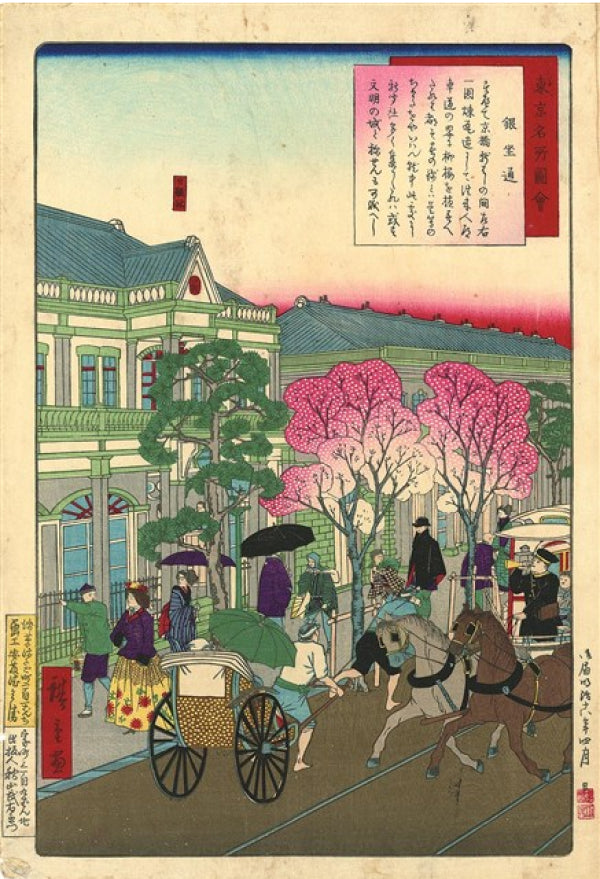
[Origin of the name Tokyo]
After the bloodless opening of Edo Castle in 1868, the new Meiji government changed Edo to 'Tokyo' in the meaning of the capital east to Kyoto. We set up Tokyo Prefecture.
In the same year, he welcomed the Emperor to Edo Castle.
Foreigner Reservation
After the Meiji Restoration, there was no shortage of commerce in Tokyo. The government opened a foreign settlement near the current Akashicho area to invite foreign traders like Yokohama. It was November 1868. The Tsukiji Hotel building was also built nearby as an accommodation for foreigners. In addition, a new Shimabara Yukaku was created for this purpose.
However, the merchants who had already settled in Yokohama did not move, and churches and mission schools were built different from the original plan, and they remained there after the closure of the reservation in 1899.
[Ginza Brick Street]
Ginza, which was hit by a fire for five years in 1869, was decided to make it a non-combustible brick town. After extending the width of the main street to about 27 meters for 15 minutes, it was entrusted to the design of the English Wartrus.
In this way, the high-call street of Ginza was completed around 1877, but at the beginning it was moist, some people became beriberi, some caps appeared on clothes, yamori, centipede appeared, and residents fled one after another, and in front of the vacant house on the main street, there were bear sumo wrestling, dog dance, peeking glasses, and archery, etc. temporarily flourished.
In 2015, railway carriages began to run on the main street, and arc lights were turned on.
However, it is only after 20 years that the residents of the back street have returned.
[Ginza Newspaper Town]
It is a newspaper company that has entered the back street where people are gone. Ginza, a commercial center, and close to the economic centers of Nihonbashi and Kyobashi, there is no such good location. The Yomiuri Shimbun, the Tokyo Nichinichi Shimbun, the Asano Shimbun, the Akebono Shimbun, the Kanayo Shimbun, the Jiji Shinpo, the Asahi Shimbun, the Yamato Shimbun, the Kokumin Shimbun, the Jiyu Shimbun, the Jiyu Shimbun, and the Meikyo Shinshi were gathered one after another to form a major information town. In addition, printing companies came after this.
[Bank of Japan and Kabuto-cho, oyster shell-cho]
When commerce was booming in Ginza, the foundation of the capitalist economy was steadily building around Nihonbashi.
In 1869, the former Tokyo Foreign Exchange Company was established in Osakacho, but it failed, and the first National Bank was established in 6 years. As of 2013, there were 24 lines in Tokyo, of which 20 were Nihonbashi, and 4 were Kyobashi.
The Bank of Japan opened its doors in 2015 and moved to its current location in 2019.
The Tokyo Stock Exchange, the predecessor of the Tokyo Stock Exchange, opened in 1878, and the surrounding area of the securities companies lined up, creating a unique town called Shima.
In addition, the U.S. trading house in Kakigara-cho merged with Kabuto-cho in 1883 to become the Tokyo Rice Exchange, and took a step toward setting an official market.
[Kanboku]
A factory like the original Debert factory where many shops sold goods side by side in a single building. It started in the middle of the Meiji 10s, but most were built in the early 1930s. The Imperial Hakushinkan, which was located at the current Hakushinkan, also opened in 1932. The passage is a slope, and the way of shopping while walking has dominated the world.
This also affected ordinary shops, and the commercial law shifted from seat selling to standing selling. In addition, many show windows have come to be seen.
 Taisho Period
Taisho Period

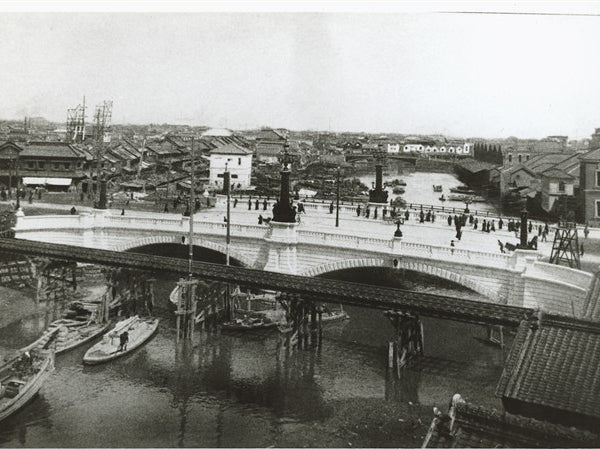
[Opening of Tokyo Station]
It opened in 1914, but it has become more convenient to walk to Nihonbashi and Kyobashi. We also improved the city’s traffic.
[The Great Kanto Earthquake]
The earthquake on September 1, 1923 and the subsequent fires caused most of Nihonbashi and Kyobashi wards, which are now Chuo-ku, to be rubble and ash. The brick town of Ginza could not be sustained.
 Showa and before the war
Showa and before the war

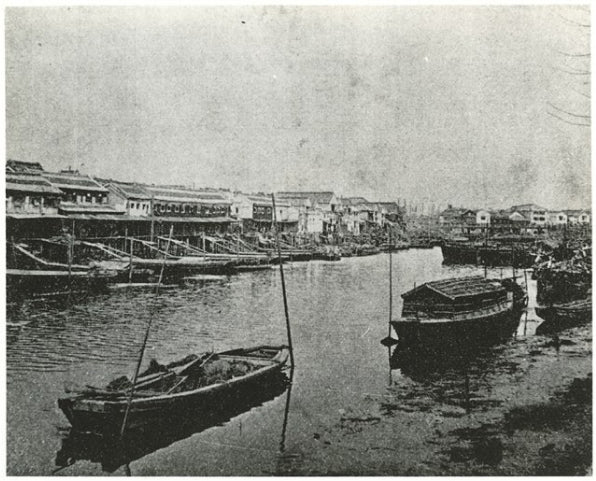
[New Town Development]
Tokyo, which was lost due to the earthquake, had to be rebuilt from scratch again. However, from the viewpoint of modernization of Tokyo, it may be said that this has yielded better results. With this opportunity, drastic urban innovation was carried out, and bright and modern city planning was promoted.
What was particularly remarkable was the building rush. Debert, theaters, hospitals, etc. were built one after another in Nihonbashi, Ginza, and Marunouchi.
[Prosperity of Ginza Street]
In Ginza, Mitsukoshi, Matsuzakaya, and Matsuya lined up three deberts, leading the way to recovery. Before the earthquake, modern shops such as Ebisu Beer Hall, Cafe Plantin, Lion, Shiseido Soda Fountain, Sembikiya were born one after another, and the cafe era came.
After the earthquake, it rekindled after the recession of 1926. Osaka Capital Cafe, which sells flashy services, has entered Ginza, has a dance hall, and coffee shops have become popular, and it has become a big cafe era.
Attracted by the atmosphere of this city, the Ginbra tribe was born. The word Mopo Moga (Modern Boy Modern Girl) was also born. However, this Gut Old Day did not last forever. In the Showa 10s, as the battle situation worsened, the brightness of the illuminations gradually became lonely.
[Opening of the Central Wholesale Market]
After the earthquake, the fish shore in Nihonbashi moved to Shibaura and operated under a tent, but it was moved to Tsukiji in 1935. The relocation issue of the Nihonbashi Fish Bank has long been a concern, but it was realized in the wake of the earthquake. At the same time, Kyobashi's green goods market was also moved here, and most of Tokyo's food was taken in one hand. In the vicinity, a shopping street was formed with market participants as customers.
[The deteriorating war situation and shopping streets]
At the time of the Manchurian Incident in 1931, I was a decent dormitory, but I started to enter the wartime system around the Nikka Incident in 2012. Ginza, which showed that prosperity, began to show shage, the dance hall was abolished in 2015, and cafe bars and high-end restaurants were closed in 2019. Instead, a porridge and a national tavern were opened here and there.
Full-scale control began in 1941, and the commercial structure itself became a distribution route. Control ranged from fiber, clothing, food, household goods to match, dust paper, and right ken.
In addition to controlling distribution, price control was also carried out. In 1938, the "Regulations on the Sales of Goods" and the "Role Control Law" were issued one after another, but prices continued to rise, so on September 19, 2002 all goods, fares, insurance premiums, rents, processing fees, etc. were suspended. Still, the government decided on the official price if it was not effective. This is the famous ○ public, and at the end of the war, it was set to over 100,000 products.
As a result of the above controls, the products that could be handled freely became stationery and booth goods, and the functions of commerce were completely destroyed.
 Showa and post-war period
Showa and post-war period

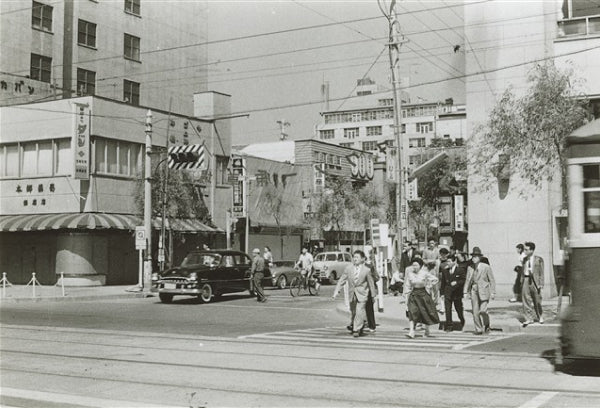
The state immediately after the defeat.
Chuo-ku was one of the worst areas affected by the war, and about 50% of Nihonbashi Ward and about 20% of Kyobashi Ward were burned down. Not only material damage, but also human damage due to death in the war and wounds was enormous.
The Prosperity of Yami City
Stallers were the first to take charge of commercial functions that had been paralyzed by wartime control after the war. Stalls lined up in Muromachi 4-chome, Yaesu-dori, Ningyocho, Kakigara-cho, Tsukishima-dori, Ginza-dori green space, etc., and illegally released items from military personnel were mainly sold.
[Reconstruction of wholesale district]
Nihonbashi Yokoyama-cho and Bakurocho were the fastest reconstruction in the wholesale district. Products were piled up in stores, and the number of buyers exceeded 30,000 a day. This was because the "Yokoyamacho / Bakurocho Wholesale Association" was organized early after the war, and the whole area was rebuilt.
As a result, Nihonbashi was revived as a commercial center in Japan, with the revival of other wholesale districts.
[Reconstruction and Transformation of Ginza Shopping Street]
Ginza was home to only 34% of the buildings that existed before the war were left due to the war and evacuation, but reconstruction proceeded smoothly as war control was lifted, probably due to the use of fire from the Edo period. Was.
However, the streets like before the war have not been reproduced.
In the past, long-established stores lined up, and dance halls, cafes, and department stores were scattered, but after the war, restaurants became the mainstay, and department stores and similar buildings increased. Following Matsuya, Matsuzakaya and Mitsukoshi from before the war, Komatsu Store, San-Ai, Meitetsu Melsa, New Melsa, and Hankyu, Sony Building, Plantin Ginza, etc. were built a little further away.
At one time, it was "Miyuki Street" that attracted more popularity than these department stores. There were more than 20 shops dealing with imported goods, and foreigners often pass, so it seemed that there was an atmosphere like a foreign country, and it was called a city that created a "population trend".
It is often said that Ginza's vitality has disappeared. Before the war, all shops were open until late at night, but now there are many shops that close by around 9 o'clock according to the provisions of the Labor Standards Law, regardless of the back street where there are many bars and restaurants, and the front street is late at night There are not many shops that are open, and people who come and go.
However, looking at the crowd on Sunday, I feel that the position of the king of the shopping district is still unwavering. Pedestrian paradise was first implemented in 1970, but since then, on Saturdays, Sundays and holidays, the main street has been opened to pedestrians, and large streets, mainly families, are filled with people, and it is bustling. I am showing.
[Development of each shopping street]
The most developed shopping district other than Ginza is the Yaesu Underground Shopping Center.
Office officials often use it for lunch breaks and return home.
If it is a shopping district closely related to the local area, it is still Ningyocho. There are a lot of old shops left because they were hardly affected by the war. Shopping streets supported by the people of the town, such as the shopping streets of Tsukishima, have also developed their own uniquely.





